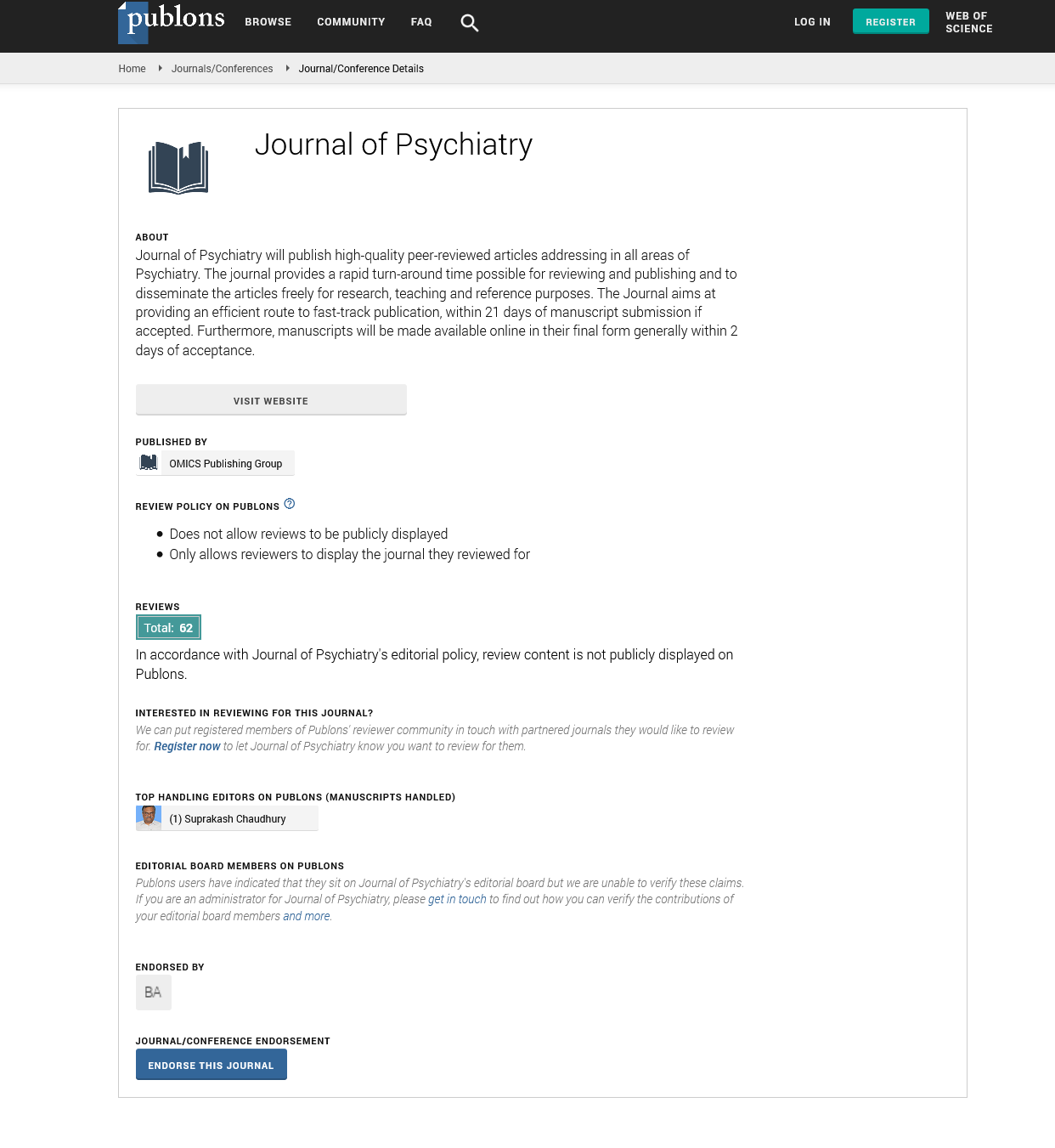PMC/PubMed Indexed Articles
Indexed In
- RefSeek
- Hamdard University
- EBSCO A-Z
- OCLC- WorldCat
- SWB online catalog
- Publons
- International committee of medical journals editors (ICMJE)
- Geneva Foundation for Medical Education and Research
Useful Links
Share This Page
Open Access Journals
- Agri and Aquaculture
- Biochemistry
- Bioinformatics & Systems Biology
- Business & Management
- Chemistry
- Clinical Sciences
- Engineering
- Food & Nutrition
- General Science
- Genetics & Molecular Biology
- Immunology & Microbiology
- Medical Sciences
- Neuroscience & Psychology
- Nursing & Health Care
- Pharmaceutical Sciences
Commentary - (2022) Volume 25, Issue 11
Effects of Specific Genetic Variants on the Transition from Psychosis to Obsession and Compulsion
Benjamin Martin*Received: 31-Oct-2022, Manuscript No. JOP-22-19097; Editor assigned: 02-Nov-2022, Pre QC No. JOP-22-19097(PQ); Reviewed: 16-Nov-2022, QC No. JOP-22-19097; Revised: 23-Nov-2022, Manuscript No. JOP-22-19097(R); Published: 30-Nov-2022, DOI: 10.35248/2378-5756.22.25.542
About the Study
A significant percentage of individuals with schizophrenia experience obsessive-compulsive symptoms (OCS). Some individuals completely go from having a psychotic disorder to having an obsessive compulsive disorder (OCD), while others go through an intermediate stage where they have both an OCD and a psychotic disorder. However, this phenomenon is not fully understood.
OCS and OCD are prevalent in people with schizophrenia, with prevalence ranging from 12.5% in people in at-risk mental states to 25% in those with early schizophrenia to up to 47% in people who are taking clozapine. There may be a biological connection between people with schizophrenia and those who only have OCD. Both have an overactive orbitofrontal cortex and have the same cognitive rigidity, slowed processing speed, and memory problems. Additionally, individuals with OCS and schizophrenia have genetic roots in "pure" OCD. Particularly, SNPs and other genetic variations in the glutamate system, including GRIN2B (glutamate receptor) and SLC1A1 (glutamate transporter), are linked to OCS in clozapine users. Despite the importance of SLC6A4 (a serotonin transporter), HTR2A, and HTR2C (serotonin receptors) in the development of pure OCD, associations with serotoninergic (5-HT) pathways have not been investigated.
In terms of epidemiology, patients using clozapine, olanzapine, or risperidone have higher rates of de novo OCS than those taking aripiprazole, amisulpride, or haloperidol. This is probably due to the varying 5-HT2A/2C receptor affinities of these medications. Despite inconsistent findings in the literature, OCS is also linked to greater clozapine doses and longer treatment durations, suggesting a dose-dependent association. However, despite plasma level being thought of as a more precise marker of clozapine impact, no prior studies have discovered relationships between clozapine plasma levels and OCS.
OCS is both prevalent in clozapine-treated individuals and linked to both the severity of the psychosis and the dosage of the drug. Here, mediation analysis revealed that the severity of the psychosis causes obsessions, which in turn cause checking behaviour. Checking compulsive and plasma clozapine levels were associated after psychosis resolution. Genetic variations linked to serotoninergic and glutamatergic transmission was discovered to influence the transition from psychosis to obsession and compulsion. We are unaware of any prior descriptions of the relationship between serotonin genetic polymorphisms and clozapine-associated OCS/OCD.
Clozapine's antagonistic effects on 5-HT2C and 5-HT2A receptors may be a feasible explanation for the maintenance of repetitive behaviour after psychosis remission. The hallmark of cognitive rigidity in compulsive behaviours, including OCD, is perseveration in reversal learning tasks, which is caused by a reduction in serotonin neurotransmission. Dietary tryptophan deprivation, which sharply lowers serotonin in the brain, favours habitual control over goal-directed control in humans. Surprisingly, a recent mouse-model study produced results that were identical. Clozapine-treated mice spent substantially more time grooming. When the selective serotonin reuptake inhibitor fluoxetine was administered, this behaviour changed back. Sapap3 mutant animals and wild-type mice had the identical effects, which raises the intriguing possibility of a genetic susceptibility to clozapine-induced habit formation.
SCL64A, 5HTR2A, and 5HTR2C are significant genetic variations of the serotonin pathway that moderate the psychosisobsession- compulsion transition. These variations may provide information on potential preventative or therapeutic strategies in the future. According to the accumulating research, therapies aimed at improving serotonin function are essential for treating clozapine-induced OCS as effectively as they do pure OCD. We did not, however, precisely examine how drug changes affected the intensity of OCS, and more study is required in this area.
Citation: Martin B (2022) Effects of Specific Genetic Variants on the Transition from Psychosis to Obsession and Compulsion. J Psychiatry. 25:542.
Copyright: © 2022 Martin B. This is an open-access article distributed under the terms of the Creative Commons Attribution License, which permits unrestricted use, distribution, and reproduction in any medium, provided the original author and source are credited.

